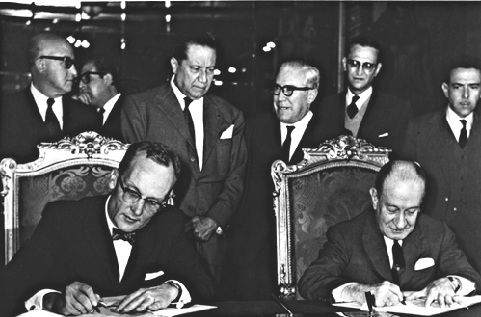|
Harmon Doctrine
The Harmon Doctrine, or the doctrine of absolute territorial sovereignty, holds that a country has absolute sovereignty over the territory and resources within its borders. Background The doctrine is named after U.S. Attorney General Judson Harmon, who made a comment during the Chamizal dispute, a dispute between USA and Mexico over the Rio Grande in 1895, in reference to international watercourses — References Stephen C. McCaffrey (1996)The Harmon Doctrine One Hundred Years Later: Buried, Not Praised 36 Nat. Resources J. 965. Rahaman, M.M. (2009'Principles of international water law: creating effective transboundary water resources management' Int. J. Sustainable Society, Vol. 1, No. 3, pp.207–223. Further readingWhat does international law say about water allocation?''United Nations Economic Commission for Europe The United Nations Economic Commission for Europe (ECE or UNECE) is one of the five regional commissions under the jurisdiction of the United Nations Econ ... [...More Info...] [...Related Items...] OR: [Wikipedia] [Google] [Baidu] |
Judson Harmon
Judson Harmon (February 3, 1846February 22, 1927) was an American United States Democratic Party, Democratic politician from Ohio. He served as United States Attorney General under President Grover Cleveland and later served as the 45th governor of Ohio. Early life Harmon was born in Newtown, Ohio and named after Adoniram Judson, the famed American Baptist foreign missionary. His parents were Benjamin Franklin Harmon and Julia Brunson, a native of Olean, New York. His ancestors on both sides of his family were English and included men who served in the colonial wars and in the American Revolutionary War, including Cornelius Brooks and his father James Brooks. Judson was a distant relative of Frances Cleveland, Frances Folsom, the wife of President Grover Cleveland, through her mother Emma Harmon. Harmon graduated from Denison University in 1866. He graduated from the Cincinnati Law School and was admitted to the bar in 1869. Harmon was elected judge of the Common Pleas Court in ... [...More Info...] [...Related Items...] OR: [Wikipedia] [Google] [Baidu] |
Chamizal Dispute
The Chamizal dispute was a border conflict over around on the Mexico–United States border between El Paso, Texas, and Ciudad Juárez, Chihuahua. It was caused by a shift in the Rio Grande, as a survey presented in 1852 marked differences between the bed of the Rio Grande (in es, Río Bravo del Norte) and the present channel of the river.''Los Angeles Times'' (December 22, 1963) "End to the El Chamizal Affair". Tensions over the territory during the historic Taft– Diaz summit almost resulted in the attempted assassination of both presidents on October 16, 1909. The Spanish word ''chamizal'' comes from ''chamizo'', the common name for the four-wing saltbush ('' Atriplex canescens'') which covered the disputed land near the present-day park. Origins (1848–1899) The Treaty of Guadalupe Hidalgo (which officially ended the Mexican–American War) defined the international border as the line along the middle of the deepest channel in the Rio Grande, continuously in tandem with ... [...More Info...] [...Related Items...] OR: [Wikipedia] [Google] [Baidu] |
Rio Grande
The Rio Grande ( and ), known in Mexico as the Río Bravo del Norte or simply the Río Bravo, is one of the principal rivers (along with the Colorado River) in the southwestern United States and in northern Mexico. The length of the Rio Grande is . It originates in south-central Colorado, in the United States, and flows to the Gulf of Mexico. The Rio Grande drainage basin (watershed) has an area of ; however, the endorheic basins that are adjacent to and within the greater drainage basin of the Rio Grande increase the total drainage-basin area to . The Rio Grande with Rio Grande Valley (landform), its fertile valley, along with its tributaries, is a vital watersource for seven US and Mexican states, and flows primarily through arid and semi-arid lands. After traversing the length of New Mexico, the Rio Grande becomes the Mexico–United States border, between the U.S. state of Texas and the northern Mexican states of Chihuahua (state), Chihuahua and Coahuila, Nuevo León a ... [...More Info...] [...Related Items...] OR: [Wikipedia] [Google] [Baidu] |
United Nations Economic Commission For Europe
The United Nations Economic Commission for Europe (ECE or UNECE) is one of the five regional commissions under the jurisdiction of the United Nations Economic and Social Council. It was established in order to promote economic cooperation and integration among its member states. The commission is composed of 56 member states, most of which are based in Europe, as well as a few outside of Europe. Its transcontinental Eurasian or non-European member states include: Armenia, Azerbaijan, Canada, Cyprus, Georgia, Israel, Kazakhstan, Kyrgyzstan, the Russian Federation, Tajikistan, Turkey, Turkmenistan, the United States of America and Uzbekistan. History The commission was established by the Economic and Social Council on 28 March 1947 in order to "Initiate and participate in measures for facilitating concerted action for the economic reconstruction of Europe," as well as to "maintain and strengthen the economic relations of the European countries, both among themselves and with o ... [...More Info...] [...Related Items...] OR: [Wikipedia] [Google] [Baidu] |
_(14595811969).jpg)

